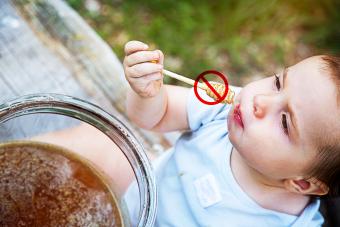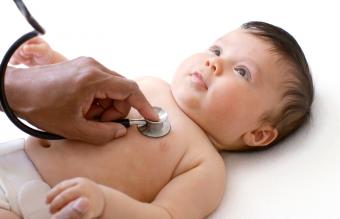
New mothers receive all kinds of conflicting advice and often find themselves asking, "Are pacifiers good or bad?" Should you use a pacifier with your baby or not? Learn about pacifier pros and cons so you can make an informed decision regarding the pacifier debate.
Why Parents Use Pacifiers?
A couple of reasons for differing opinions among parents regarding pacifier use is the fact that not every baby is the same and not everyone's parenting example is identical. On a personal level, a mother who has a baby that sleeps through the night within the first month would most likely have a different opinion than the mother who has a colicky infant. Others may use a pacifier because their mother used one. The bottom line is that those who use a pacifier do so to "pacify" their baby or toddler. But it is recommended to try rocking or doing a position change to calm a crying baby before resorting to the pacifier.
Pros of Using a Pacifier
This insights above only touch the tip of the issue over whether to use a pacifier. Here are a few other aspects and arguments regarding the pros of using pacifiers that fuel the debate:
Pacifiers and SIDS

Some people buy pacifiers because they believe that using a pacifier decreases the chance of sudden infant death syndrome (SIDS). This is typically because babies who are given a pacifier when falling asleep don't sleep as deeply as babies who do not use a pacifier.
Better Than Sucking Their Thumb
Some sonograms show babies sucking their thumb in the womb. The need to suckle is stronger in some infants more than others. One more reason parents may choose to use a pacifier is to prevent a thumb sucking habit. One benefit of a pacifier compared to thumb sucking is that a pacifier can eventually be taken away from the child.
Pacifiers Help Premature Babies
Hospitals suggest that premature babies who are given pacifiers seem to grow better.
Pacifiers Are Stress Relievers
Professionals also consider the pacifier to be a transitional object. As such they are believed to aid children in releasing stress when adjusting to new situations.
Pacifiers Are Calming
It has been found that the use of pacifiers is overwhelmingly effective in soothing and calming crying babies and toddlers.
Pacifiers May Help on a Plane
Sucking on a pacifier may help your baby 'pop' its ears while on a flight. This will help relieve the ear pain experienced by the changes in air pressure.
Pacifiers Aid in Sleep
It is known that pacifiers help a baby fall asleep and ultimately stay asleep. Parents often wonder if a baby can sleep with a pacifier all night. It is actually considered safe for your baby to use a pacifier at bedtime or naptime as long as the pacifier you choose is designed for your baby's age. The familiar sucking action will provide a comforting, calming effect.
Pacifiers Are Safe in the Crib
A pacifier in the crib is generally safe. One safety concern is choking hazards. You want to be sure you use the pacifier that is designed specifically for your baby's age so it will fit properly. It is always best to inspect your baby's pacifier regularly to look for torn or deteriorated parts that could break off. If necessary, replace the old pacifier with a new one. Another safety concern is the strap that is attached to the pacifier can become a strangulation hazard. Therefore, you should never attach the strap of the pacifier to your baby's crib, bedding or clothes.
Cons of Using a Pacifier
Of course, not all ideas about pacifier usage are positive, as there can be negative effects associated with using them. Cons associated with pacifier use include:
Nipple Confusion
There are people who point to the problem of "nipple confusion" when a nursing baby is given a pacifier. This problem does arise for some nursing babies who are given bottles or pacifiers but it is not an across the board problem for all babies.
Pacifiers and Ear Infections
The use of pacifiers may lead to ear infections and that limiting use to only when the baby is falling asleep can greatly reduce the chances of an infection.
Pacifiers May Lead to Bad Teeth and Braces
While some parents use a pacifier to stop thumb sucking, the prolonged use of a pacifier can lead to the same problems as thumb sucking. A pacifier may be bad for teeth. These problems include:

- Improper growth of the mouth itself.
- Misalignment of teeth and crooked teeth.
- Changes in the shape of the roof of the mouth.
- An overbite, crossbite or open bite.
- Changes in tooth position and jaw alignment.
- Front teeth not meeting when the mouth is closed.
Pacifier May Lead to Poor Oral Hygiene
Pacifiers may contribute to poor oral hygiene when they are reused without cleaning.
Pacifiers Are Not the Most Effective Way to Calm
It has been found that breastfeeding (not pacifiers) is actually the most effective way to soothe and calm infants.
Pacifiers May Affect Baby's Natural Behavior
A pacifier can also train a baby to think that crying is unacceptable behavior which is the infant's main form of communication.
Pacifier Recommendations
It is best to introduce a pacifier once the baby has established breastfeeding. This is when the baby is at 3 to 4 weeks old. The following are recommendations for the best pacifiers for newborns which include:
- Nuk Breeze Orthodontic Pacifier is an orthodontic pacifier and handle-free. It has a unique shaped nipple, is stain-resistant and easy to clean.
- MAM Orthodontic Pacifier has a soft silicone nipple with an anti-slip surface to help keep the pacifier in the baby's mouth. It is small, lightweight and handle-free.
- Philips Avent Soothie Pacifier is a one-piece pacifier and made of high-quality material. It is a good 'starter pacifier' to see what your baby may like.
- Philips Avent Nighttime Pacifier is a well-constructed and has a glow-in-the-dark handle and snap-on nipple cover. It is easy to find in a dark room but does need to be replaced monthly.
- Playtex Binky Silicone Pacifier has a round nipple shape. It is more traditional with cute designs and is a good value.
- WubbaNubs Pacifier has a Soothie pacifier attached to a small, very cute stuffed animal. This enables the baby to keep the pacifier in their mouth longer and hold on to the stuffed animal as well.
- Natursutten Pacifier is a Danish-made natural rubber pacifier. The shield is oversized and designed to touch the baby's nose which simulates breastfeeding. But they are not safe if your baby has a latex allergy.
When to Take Away a Pacifier
Pacifiers give your child a sense of security, therefore, taking away a pacifier is never an easy process. But the risks of using a pacifier begin to outweigh the benefits as your child gets older. Some ways to help your child stop using their pacifier include:
- Phasing out the pacifier once your child is 2 or 3 years old. Your child should definitely be rid of their pacifier by age 4.
- Using a gradual approach to wean your child off the pacifier.
- Using praise when your child chooses not to use their pacifier.
- Being prepared when you hear them say or cry that they want their pacifier again.
- Deciding if there's a need to talk to your child's doctor or dentist because your child is struggling to give up their pacifier.
Keep the Pacifier Clean
If you do decide to use a pacifier, it's important to keep it clean. For infants, pacifier care should include daily cleaning in boiling water, or it can be cleaned by running them through the dishwasher. Once your baby is six months old, the pacifier can be washed each day in warm, soapy water and rinsed well.
Yes or No to the Pacifier
All this brings us back to the question: Are pacifiers good or bad? With conflicting information, it comes down to a matter of choice on the parents' part. Some pediatricians are against them, and others recommend them. Another common question is: Are pacifiers necessary? Since every baby is different, each will have their own comfort sucking needs. The bottom line is that a pacifier should be used to satisfy a baby's need to suck. So, yes, a pacifier may be necessary for your baby. If you do decide to let your baby use a pacifier, just be careful they do not overuse it.







